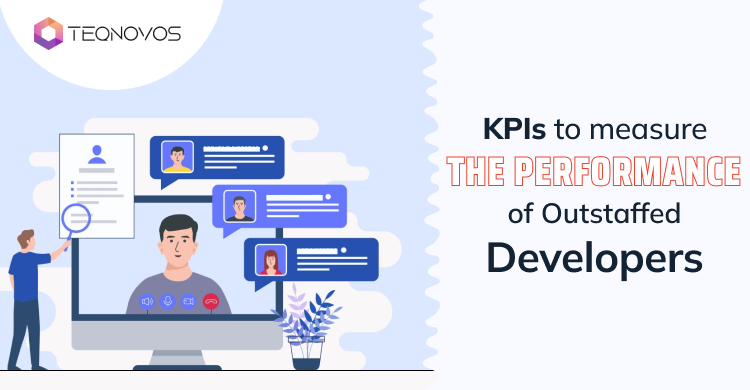KPIs to Measure the Performance of Outstaffed Developers
No matter how talented developers you have hired for your project, it’s essential to measure their performance from time to time. Doing so will help you identify any bottlenecks in the development process and the challenges faced by developers. When you outstaff developers who are working remotely on your projects, it becomes crucial to choose the right KPIs to measure the performance of outstaffed developers.
Whether you are already working with remote developers or planning to outstaff developers for your team, you may be interested in knowing the top KPIs. In this blog, we’ll talk about the importance of KPIs and list down the most popular KPIs to leverage while working with outstaffed developers. So, let’s not waste any time and get started!
What is the Importance of KPIs?
KPIs or key performance indicators allow businesses to collect, organize, and analyze particular data that help to make well-informed decisions. The use of KPIs to measure performance is common across the majority of industries. In the IT industry, we utilize KPIs to determine how well a software development team performs.
Especially, when working with remote developers and development teams through arrangements like outsourcing and outstaffing, the use of KPIs becomes imperative. This is so because managing remote developers is a bit challenging compared to in-house developers.
By setting up KPIs, you streamline the performance measurement process. Thus, making it easier to find issues that hamper the productivity of developers and take corrective actions at the earliest.
Top KPIs to Measure the Performance of Outstaffed Developers
While choosing metrics for assessing the performance of your outstaffed developers, you will come to know that there exists a large number of KPIs, and selecting all of them is impractical. So, how do you identify which KPIs to go for?
Well, we have curated a list of the most popular KPIs to measure the performance of outstaffed developers. As someone who has little experience in utilizing KPIs to track the performance of software developers, these KPIs are the best ones that you need to consider. Let’s take a look at them below.
1. Velocity
Velocity, as a performance indicator, defines the amount of work that a software development team accomplishes in one single sprint or a specified time duration.
With this metric, you can get a fair estimate of the tasks that your development team accomplishes in a given time period. By assessing the average velocity of your outstaffed development team, you can guess the amount of time required to complete a project.
Velocity is usually measured in two different ways – issue count and story point. While the issue count considers labeling a task as either done or pending, the story point takes into account the complexity of each task.
2. Cycle Time
The cycle time represents the total time needed to complete a particular task or process. We count cycle time from the moment when the development team starts working on a task till the completion of the task.
This indicator is popular among managers as it allows them to measure the speed and efficiency of the development team. Moreover, due to the objective nature of cycle time, it comes in handy for planning sprints.
3. Lead Time
Lead time is an extended version of the cycle time. It starts counting time right from the moment the development team comes up with the idea of a task. In other words, lead time considers the total time required to move a task from the ideation stage to the completion stage.
As lead time takes into consideration the time involved in planning a task, it emerges as a useful metric for setting realistic deadlines.
4. Sprint Burndown
This indicator allows you to assess the rate at which your development team accomplishes work during a sprint.
With the help of a sprint burndown chart, you can view both the completed tasks and the remaining tasks at any point in time during a sprint. By analyzing the sprint burndown chart, it becomes easier to decide if you need to make any adjustments to ensure the timely completion of tasks.
5. Release Burndown
The release burndown KPI allows you to measure the rate at which your development team accomplishes work for a new product release.
Release Burndown is somewhat similar to Sprint Burndown. However, it measures the work against the new release instead of the sprint. A release usually involves multiple sprints, and thus, release burndown is a broader KPI compared to sprint burndown.
One significant benefit of release breakdown is that it helps you to figure out if your developers will be able to release the product on time.
6. Throughput
Throughput is a performance metric that indicates the total work or output delivered by the team. With this metric, you assess the total number of tasks accomplished by your development team in a certain time period.
One particular thing to note here is that throughput only considers the tasks that are completed. Tasks in progress and yet to be started are not considered. With throughput, you can easily evaluate your development team’s productivity and identify the most time-consuming tasks.
7. Deployment Frequency
This KPI helps you track how often your development team produces and deploy new code. It considers the addition of code for both new features as well as bug fixes. Deployment frequency as a metric is beneficial when your development team works on a project with dynamic requirements.
By knowing the deployment frequency of your team, you can predict the time needed to fix a bug or add a new feature to the software.
8. Code Churn
Code churn is a measure of the frequency of the changes made to the source code. Every time your out-staffed developer makes a change to the source code of a project, you count it as a single occurrence of code churn.
This KPI turns out to be extremely useful for measuring the actual productivity of developers. Reworking code frequently means that your developers are making errors in code, which is counterproductive. High code churn indicates poor coding skills.
9. Mean Time Between Failures
This performance metric tracks the average time between the two failures of software. It’s easy to calculate the mean time between failures (MTBF). Divide the total number of days or hours the system is up and running in a specific period by the total number of failures that occurred during the same time period.
MTBF lets you gauge the reliability of the product as well as the coding skills of your developers. If the mean time between failures is low, it means that your developers did a great job in developing a reliable software product.
Key Benefits of Using KPIs to Measure the Performance of Developers
Following are some notable benefits that you get by using well-defined KPIs to measure the performance of your outstaffed developers.
1. Work with Facts
When you use KPIs to rate the performance of your outstaffed developers, you work with facts. Your assessment is not biased by opinions.
2. Align Developers’ Efforts with Business Objectives
When you outstaff developers, you hire them on a full-time basis. It means that while they work remotely, they are an integrated part of your business. So, it becomes essential to ensure that they contribute to the success of your organization by helping achieve the desired business goals and objectives.
With KPIs in place, it becomes easy to set performance standards. Whenever the efforts of outstaffed developers seem moving in the wrong direction, the KPIs will help you detect the anomaly so that you rectify it as early as possible.
3. Plan and Prioritize Tasks Easily
When you outstaff developers, you need to carefully plan and prioritize tasks to accomplish the work on time. KPIs allow you to identify and prioritize tasks that are crucial for the success of a project.
4. Keep Everyone on the Same Page
KPIs let you collect and present information related to a project in an understandable way. Whether it’s about the project progress, the performance of developers, or the possibility of timely completion of a project, there are KPIs for each of them. It’s also possible to share information easily with everyone involved in the project, including shareholders, and get everyone on the same page.
Final Thoughts
Outstaffing is a great way to hire talented developers with different skill sets for your team. With outstaffing, you have the option to hire full-time remote developers quickly and at reduced costs.
However, while working with outstaffed developers, you may need to assess their performance and ensure they are moving in the right direction to ensure the success of your projects. This is where the need for KPIs arises.
By leveraging KPIs, you collect and analyze data to extract information that helps you improve the productivity of outstaffed developers, prioritize tasks, and keep everyone on the same page.
If you want to hire the most talented remote developers working remotely for your business, you should consider giving our world-class outstaffing services a try. At Teqnovos, we have developers with knowledge of a wide array of development technologies, including JavaScript, React, Angular, Vue.js, Next.js, Python, PHP, Laravel, WordPress, Shopify, Salesforce, and much more. Get in touch with us today to build an agile development team for your business.
Frequently Asked Questions
1. How do you measure the success of outstaffed developers?
Through different KPIs, you can conveniently measure the success of your outstaffed developers. KPIs let you collect factual data that you analyze to assess the performance of your outstaffed developers.
2. What are the best KPIs to assess the performance of an outstaffed development team?
There are many KPIs that are suitable for measuring the performance of an outstaffed development team. However, you have to choose the ones that best meet your requirements. Nonetheless, the most popular KPIs include velocity, lead time, release burndown, throughput, deployment frequency, and code churn.
3. What is the KPI in development?
KPI stands for Key Performance Indicator, and it gives us a way to measure the performance of a system, individual, or team. In software development, we use various KPIs to gauge the progress of a project and the performance of an individual developer or the whole team. With KPIs, it becomes possible to trace issues that affect the quality of deliverables and the timely completion of a project.
















